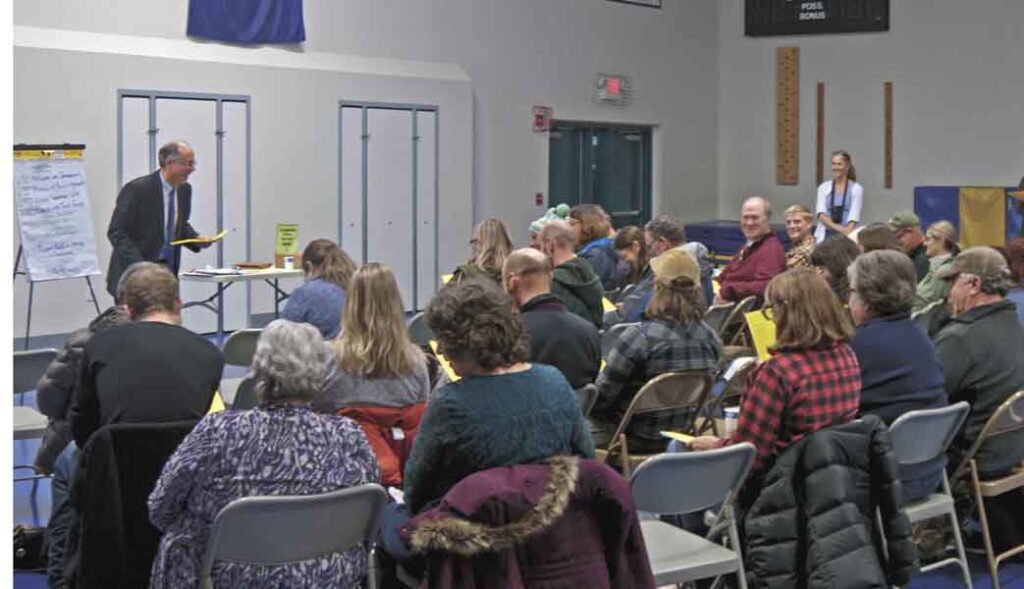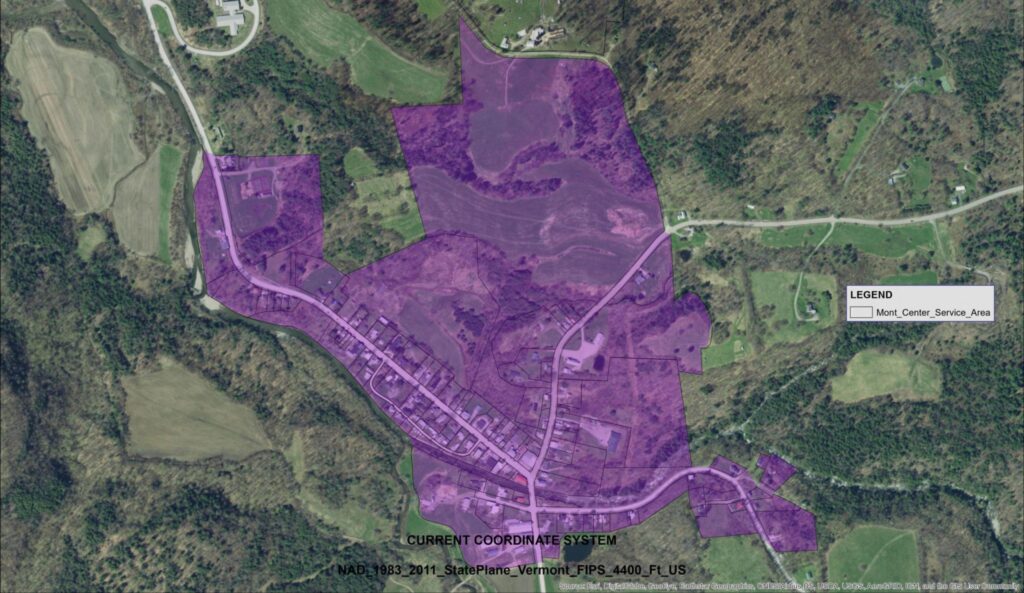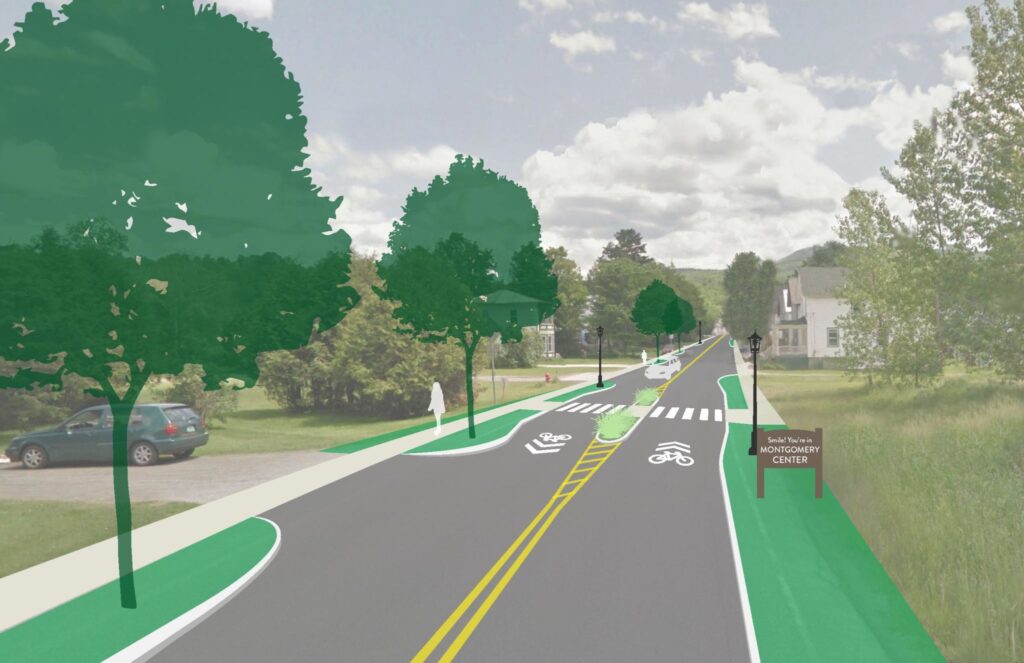Report a Road or Water Issue
Scott Ovitt, Road Foreman
montgomeryroads.scott@gmail.com
Town Garage: 802-326-4418
Road Emergency: 802-370-5650
Water Emergency: 802-309-8574
Scott Ovitt, Road Foreman
montgomeryroads.scott@gmail.com
Town Garage: 802-326-4418
Road Emergency: 802-370-5650
Water Emergency: 802-309-8574

Official Municipal Website

Official Municipal Website
Let’s build our future for the lowest cost we’ll see in decades.
A decision has been issued by the Zoning Administrator for the following permit: Howarth 1-8-26
The Zoning Administrator has issued a Notice of Public Hearing-Development Review Board for Eller 1-22-2026
After counting nearly 400 votes on two bond articles both resolutions passed on July 7th, 2020.
| In Favor | 207 |
| Opposed | 163 |
| Blank | 2 |
| In Favor | 195 |
| Opposed | 177 |
After 2 years of exploratory work, input from 200+ residents, 8 public meetings, 2 studies, and narrowing 15 priorities down to 3, the opportunity before us is very clear: Our community has a chance to build for the future at the lowest cost we’re likely to see in decades.
Montgomery Thrives is eligible to receive up to 75% of the project cost in grants from the USDA alone, interest rates are at historic lows, and more attention from policy makers—and public dollars—is being turned every day towards infrastructure projects as a means of economic recovery.
This site is intended to be a clearing-house for information and updates on the projects. A place to learn more, get your questions answered, and keep up to date with the latest and greatest.



On July 7th, vote ‘yes’ and give Montgomery Thrives the ‘yellow light.’ The Town of Montgomery, Vermont is excited to share this summary of the great efforts undertaken to advance two of the key priorities established in the Montgomery Thrives effort:
(Read the 2019 VCRD Report and Action Plan)
As a community we are in a unique position to make a lasting and substantial change for the future of Montgomery. By improving municipal infrastructure, these projects will position Montgomery to rebound stronger from the economic slowdown focusing on a long-term vision for the Town’s vitality over the next 30-50 years.
To be incredibly clear—an affirmative vote should be considered a yellow light from the community to advance the project.
The town is pursuing multiple funding avenues, but the primary source will be a low-interest grant/loan package from USDA, which requires the town to approve the borrowing authority for the full project amount as a demonstration of support for the project, even though the final amount of actual indebtedness would be a fraction of that.
Without an affirmative vote, the USDA will not extend an offer to us. What we’re looking for now is the offer from USDA, because without it the project is dead in the water.
That’s why we need a ‘yes’ on the bond vote: To get the USDA to earmark the funds for us. To start carefully. If moving forward we discover roadblocks or impediments (including cost) that don’t make the project feasible we’re under no obligation to take the money and actually issue the bonds. The town is pursuing numerous state and federal grant programs to offset the project cost.
The board realizes that an $18 million project is difficult to wrap our heads around, no more so than during a time of uncertainty such as we face now, but the opportunity before us is clear: our community has a chance to build for the future at the lowest cost we’re likely to see in decades. Debt is never something for a town to take lightly, and this project deserves all our careful consideration.
You can track project updates made here by following the Town Clerk’s Office Facebook page [no longer active], and by attending the public information meetings on June 30th, July 2nd, and July 6th (2020). These meetings will be held virtually via Zoom and will also be recorded for viewers to watch at their convenience prior to the July 7th, 2020 bond vote. As restrictions around larger gatherings continue to relax, in person gatherings to discuss the project may also be scheduled.
How we got here (and where we’re headed):
In January of last year, the town of Montgomery came together to discuss and select priorities for the community. The process, Montgomery Thrives, followed numerous Selectboard discussions around how to better engage the community in setting priorities.
Over 250 committee members participated, and in the end three priority areas emerged: a wastewater system for the center and village; streetscape improvements to enhance safety and catalyze greater economic development; and increased access to broadband internet.
At Town Meeting 2019, the community voted to advance a feasibility study for the infrastructure improvements.
On Monday, June 1st, after an eight-month process of preliminary engineering and continued community engagement in selecting alternatives, the Montgomery Selectboard adopted a Resolution to advance a July 7th bond vote for a Municipal Wastewater and Streetscape project in the amount of $18 million.
Jul. 8, 2020 | The St. Albans Messenger • The town is already in discussions with USDA Rural Development to cover a hefty portion of the price tag. But before those arrangements can be finalized Rural Development requires a positive vote from the community on the total project cost. […]
Jul. 2, 2020 | The St. Albans Messenger • The town is already in discussions with USDA Rural Development to cover a hefty portion of the price tag. But before those arrangements can be finalized Rural Development requires a positive vote from the community on the total project cost. […]
Nov. 30, 2018 | The St. Albans Messenger • A community initiative dubbed Montgomery Thrives entered a new phase this Thursday as residents organized into specialized committees and drafted the first steps of their plans that, if realized, could lead to substantial developments for the small mountain town […]
Nov. 14, 2018 | The St. Albans Messenger • Working with the Vermont Council on Rural Development’s Community Visit program, Montgomery residents have identified projects and goals to guide and promote growth in the community including pedestrian and traffic infrastructure, cell phone access and wastewater treatment […]
As a result of the Montgomery Thrives effort and 2019 Town Meeting vote, the Town proceeded with the development of preliminary engineering to establish wastewater design alternatives for the Village and Center that scaled the level of investment and improvements for consideration.
Through this effort, three collection-and-conveyances and four treatment-and-infiltration Town-owned wastewater systems were designed.
The Town selected the grinder pump collection and conveyance alternative and three separate septic tank and infiltration areas to serve the Village, Center (North) and Center (South) areas as the lowest cost of the many alternatives considered.
View high-resolution PDFs (via Google Drive)
In January 2020, the Town held a public Local Concerns Meeting specifically for the Streetscape scope of work associated with the wastewater improvements. The meeting was focused around introducing the project team, describing the project scope and schedule, and garnering local and regional comments.
The design team developed two Village streetscape alternatives as well as three Center streetscape alternatives and the Town selected the preferred conceptual designs.
View high-resolution PDFs (via Google Drive)
Get high-resolution copies of the Preliminary Engineering Report.
This is a complex project, and every careful decision requires good information. We’ve compiled an extensive FAQ that may help answer your specific questions.
Replacement of 165 on-site septic systems for properties in the Village & Center with a Town owned/ operated low pressure sewer & treatment system to serve the future Town needs.
The system will be designed to support both present needs and future growth in these areas (increasing capacity for existing businesses and residences and for future build-out).
Improvements include better defined and connected sidewalks, on- and off-street parking, traffic calming features, lighting, tree plantings, as well as many other features and amenities to create safe and functional facilities.
Wastewater project cost is $11.8M. The Streetscape project cost is $6.985M based on the preferred conceptual alternatives developed during preliminary engineering—including construction costs, 15% contingency, land acquisition, engineering & construction inspection, legal, and permitting costs.
While this is the total project cost, it is not what the town would eventually bond for. This amount is subject to reduction through any state or federal grants-in-aid received.
To secure a loan/grant offer from USDA, the town needs to approve the borrowing authority for the entire amount.
This is a demonstration of community support for the project, and a pledge of the full faith and credit of the Community for the project. Without an affirmative vote, they will not extend an offer.
We have LOADS of details to we still need to work out, which will be addressed during final engineering. We also need to secure additional funding sources.
What we’re looking for NOW is the offer from USDA, because without it the project is dead in the water. That’s why we need the bond vote—to get USDA to earmark the funds for us.
If moving forward we discover roadblocks or impediments (including cost) that don’t make the project feasible we’re under no obligation to take the money (and actually issue the bonds).
Funding. The Town submitted for two USDA project funding programs—the Wastewater Project under the USDA Rural Development program and the Streetscape Project under the USDA Community Facilities program.
The Town received a USDA SEARCH Grant to cover Preliminary Engineering in the amount of $30k.
We also received an Agency of Natural Resources Engineering Planning Advance (EPA) in the amount of $82k to support this work (which was subsequently amended to increase by $49,996, for a total of $131,996.
The USDA funds are a grant, whereas the EPA funds are a loan that only needs to be paid back if the project advances.
The town has applied to USDA Rural Development for $11,724,000 to support the construction of the system (which would come as grant/loan package, with the town potentially eligible for up to 75% grant).
The town has also applied for a $1M grant from the Northern Borders Regional Commission. In addition, Montgomery made the State’s Clean Water State Revolving Fund (CWSRF) Intended Use Plan for $650k for final engineering, and $12M for construction.
The town is eligible for (and applying for on July 1st) a $125k subsidy from the fund to support final engineering. The Town has identified numerous additional grant opportunities and will be applying for them.
The Town has applied for a very low interest rate USDA Community Facilities Loan for $6,985,000.
This will allow the Town to complete the final streetscape design while seeking other grant sources including State & Federal programs to fund between 70% and 90% of the total streetscape costs.
The two project phases will be considered separately:
Wastewater
Vermont statutes dealing with municipal sewer systems are predicated on user-pay, requiring the municipality to set and collect rates sufficient to pay operation and maintenance costs of the system, pay debt service on the bond, and fund system capital reserves. Remember, the eventual capital cost (bond amount) would be whatever isn’t covered by grant dollars.
System revenues can be used for no other purpose. Managed properly, municipal wastewater systems are self-sufficient. So, the source of paying for municipal water and sewer systems is system revenue.
On the other hand, security for water and sewer bonds is a pledge of the municipality’s full faith and credit—which is why the bond vote is required.
That said, the town could choose to institute a Sewer Benefit Assessment (described below) to spread the burden out (similar to how Montgomery has paid for our water system).
Streetscapes
The final cost of this project, following receipt of all outside sources, will be a bond shouldered by the whole community, similar to that for a Fire Truck, or Town Garage.
Our target is to get up to 90% of the project cost covered by grants.
Statute gives the town a menu of options in establishing sewer user rates.
The imposition of a sewer benefit assessment would apply to all property within the municipality, regardless of whether it is currently hooked into the sewer system, or if there is no possibility that it will ever be connected.
The sewer benefit assessment generally is a function of grand list assessed valuation.
Imposition of a sewer benefit assessment is a recognition that having wastewater pollution abatement facilities confers upon the municipality at large benefits in the form of, for instance, enhanced property values by virtue of the availability of public sewers.
Final user fees will be based on the level of outside funding or grants the town is able to secure, though the project has a goal of getting costs below 1.5% of mean household income for Montgomery (about $633 annually).
Yes. All parcels within the service area will be required to connect to the system.
Low sale prices of homes in the villages due to their septic limitations are already depressing real-estate values, and limited capacity threatens the viability of many local businesses.
The construction of a municipal wastewater system can raise property values, spur businesses growth, and increase the tax base.
Our back roads and our village centers raise and fall together.
The construction schedule for the wastewater system construction is estimated at 1 year.
The streetscape work can be completed within 1 year as well, but the Town will consider alternatives for phasing and restricting seasonal work during the preliminary design phase.
It’s a system that uses small-diameter pipes and grinder pumps that collect all the disposal from homes and grinds it into slurry.
The wastewater is then pumped to a larger low-pressure sewer main directly to a treatment plant.
Construction will replace the existing septic tank with a buried grinder pump unit near your building.
The 30” diameter access cover and a nearby mounted small electrical control box is all you will see after construction.
A grinder pump collects the building’s wastewater, grinds up the solids, & pumps it to the sewer system through small-diameter pipes.
Yes! This new system will eliminate 165 individual septic systems with an area-wide system that will serve to address the public health & environmental risks associated with failing sewage disposal systems.
The grinder pump station receives all the home’s wastewater (toilets, sinks, etc.) via gravity and collects it in a tank.
When the determined wastewater level is reached, the pump turns on automatically and pumps the wastewater to the sewer main.
With an outdoor buried unit—at 10-15 feet away—you will not hear it. If you are standing on top of it, it hums like a washing machine (69 dB at 6 feet).
Typically, a total of 10 to 30 minutes per day for a single-family residential home.
It is designed to turn on 20-40 times, for 1 to 2 minutes each time, throughout the day. This will vary with water usage —the more water you use, the more often the pump will turn on.
A typical Vermont single-family home uses approximately 210 gallons of water per day. A typical grinder pump will consume about $12 in power operation each year.
Water, toilet paper, and human waste. Just like any other disposal system, grease, paint, chemicals, kitty litter, feminine hygiene products and personal/cleaning wipes should never be put into the drain system.
No. The Town will own, operate, maintain, repair, and replace all wastewater infrastructure when needed.
Yes. 12 defined parking spaces will be added at the Village Green and over 100 designated spaces will be marked both on-street and in an off-street lot in the Center.
Raised sidewalks throughout provide safe separation between pedestrians and vehicles.
The existing sidewalk will be extended southeast on Route 118 and transition to a 10′ shared-use path to the Valero station.
These sidewalks will guide users to marked crosswalks for safe crossing.
A green space for stormwater treatment and plantings for aesthetic improvements as well as traffic calming measure at the entrance of Montgomery Village.
It’s a shared lane pavement marking for vehicles & bicycles, identifying that they are responsible for slowing speeds & merging.
Common in village & downtown settings, this maximizes the right-of-way use while defining spaces for parking, traveling vehicles & bicycles, & sidewalks.
Yes—to answer the need for better defined Village parking for events and the Farmers Market.
With one-way traffic flowing around the Green, it allows for space for parking, pedestrian facilities, improved access and usage of the green, and safer intersections.
Curbing and raised sidewalks will be installed to aid in traffic calming while providing vertical separation between pedestrians and traffic.
The Route 118 sidewalk will be extended northwest to the Recreation Center and fully connected on both sides of Route 118 within the main strip of the Center.
After a lot of analysis, a three-way stop intersection was determined to be the best alternative.
Flashing approach signs will alert motorists to the stop ahead. This change can yield the greatest traffic calming and pedestrian safety improvements for the Center.
On Route 118 greenspace bump-outs will provide traffic calming and enhance the small-town aesthetic with street trees and decorative lighting (burying the remainder of utilities, so no overhead wires!).
A kiosk area in the off-street parking lot will provide information to unfamiliar patrons and a gateway will be installed on Route 118 to designate the community’s Center.
Yes. Village improvements were designed according to the state highway right-of-way restrictions.
The Center project will require the Town to take ownership of this small segment of Route 118—from the cemetery to the Trout River Bridge.